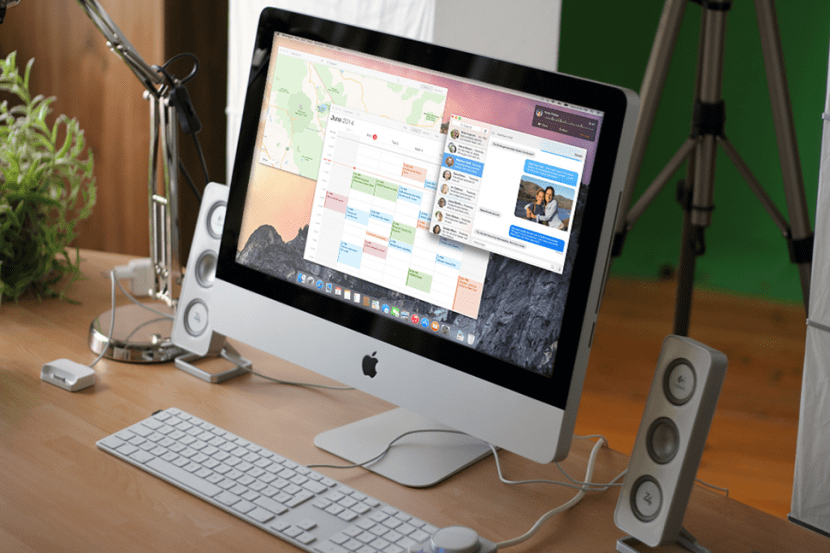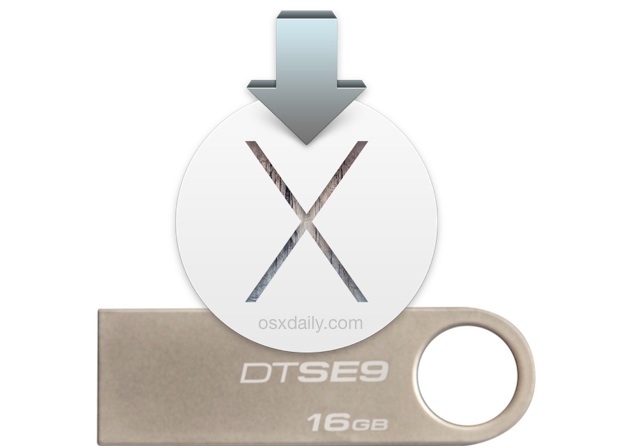A previous commenter on our How To Speed Up Your Mac article noted that the biggest speed up they experienced for their Mac was to re-install OS X from scratch from a USB disk. Whilst this is a bit disappointing because it’s one of the things I had hoped to escape when I made the switch from Microsoft Windows all those years ago, it makes a fair bit of sense – particularly if you’re one who often plays with software then deletes it again like I do for reviewing stuff, since lots of cruft gets left laying around… (I tried using Parallels Desktop 10 to run an alternative OS X platform for doing my reviews – it was too slow).
- Install Os X Yosemite From Bootable Usb
- Mac Os Yosemite Vs Sierra
- Download Os X Yosemite Without App Store
The instructions I found that worked, using Disk Utility, were located at How to Make a Bootable OS X Mavericks USB Install Drive and How to Create a Bootable Install USB Drive of Mac OS X 10.10 Yosemite. Download the Mac OS X 10.10 Yosemite. First, download the latest Mac OS X version, which is 10.10 Yosemite. How to Install Mac OS X Yosemite on a USB Flash Drive By Jennifer Kyrnin and Mark Spoonauer 29 August 2014 You might want to try out Yosemite but not modify your primary Mac.
The process isn’t all that straight forward and the commenter asked if we would do a How To, so here it is.
The first thing you need to do, as with any major undertaking you might do with your Mac, is to BACK IT UP. Get yourself a Time Capsule from Amazon, eBay or (if you’re in Australia) somewhere like JB Hi-Fi and back up your Mac using Time Machine. Or check out our article about Crashplan if you prefer not to shell out exorbitant amounts of money on a Time Capsule. We can’t stress this enough – you must back up your Mac before continuing. The process outlined below will delete all your data. Everything. Kaboom. So back it up.
While your Mac is backing itself up somehow, go to the Mac App Store and download Yosemite. It’s a big download and if you’re in Australia like me it’ll take a while thanks to our ageing infrastructure and lack of government foresight to get us into the 20th Century of broadband (but I digress into a political debate). DONT OPEN IT. The download will create a link in your Applications folder called ‘Install OSX Yosemite’. Don’t open it yet. Doing so will install Yosemite indeed, but it’ll be an upgrade over the top of what you already have and it’ll delete itself after it’s re-installed. This is not what we want if we’re putting it on a USB. If it opens automatically, simply close it.
You’ll need an 8Gigabyte USB key – which you can pick up at just about any corner store these days.
Plug the USB key into your Mac and if necessary re-format it using Disk Utility so that Yosemite can be written to it. To do this, open Disk Utility, select the USB key on the left and choose the Erase Tab. Choose Mac OS Extended (Journaled) and leave the title as ‘Untitled’ for now. The process of putting Yosemite onto the USB key will rename it anyway.
Now we’re (unfortunately perhaps) going to have to get a little bit familiar with the Terminal application. Open up Terminal (its under Applications -> Utilities if you’ve never used it before). The instruction you need to type assumes you have simply downloaded the ‘Install OS X Yosemite’ application into your applications folder. You’ll need to modify the locations if you’ve managed to download it somewhere else.
sudo /Applications/Install OS X Yosemite.app/Contents/Resources/createinstallmedia –volume /Volumes/Untitled –applicationpath /Applications/Install OS X Yosemite.app –nointeraction
The sudo command at the beginning will ask you for your login password. If your Mac logs in automatically, it’s the same password that you may have used in the pop up windows that occasionally come up when you install new programs.
The createinstallmedia command will give you some (fairly inaccurate) feedback about how far through the process it is, but you can expect it to take anywhere up to 20 minutes depending on how quick your Mac can read from the internal disk and write to the external USB which are typically quite slow. Don’t interrupt the process – don’t turn off your Mac, don’t pull out the USB key, don’t eject the USB key from Finder. Doing so will corrupt the flash key and you’ll need to start again. The process is finished when you see ‘Copy Complete. Done’ in the terminal window.
That’s the hard part over with. Now you need to reboot your Mac ( hope you’re reading this on an iPad or something similar so you can still follow while you reboot! ).
As soon as you hear the Mac bootup ‘Chime’ hold down the Option (or Alt) key and select the USB drive (which should be an orange colour). Double click the icon with the mouse or use the cursor keys to move to that image and then press Enter. This will start the Yosemite Installer, which may take a few minutes depending on the speed of your USB key. When everything is started you’ll see an Installer screen with a number of options. You need to choose the Disk Utility option first of all. If you miss this step you’ll end up just installing Yosemite over itself and you won’t benefit from a fully clean install. When Disk Utility is started click on Macintosh HD (or whatever your internal hard drive is called that you’re going to install Yosemite to) – it’s probably the top drive listed. Just as you did for the USB key, do now for the hard drive – i.e., choose the Erase Tab, choose Mac OS Extended (Journaled) and set the title to whatever you want. This will erase all your files from that disk. Everything. You did backup didn’t you?
Once that process is complete, Exit Disk Utility and choose Install OS X – choosing the freshly erased Hard Drive when the installer asks you.
Once everything is finished and you reboot, you’ll see your shiny new Yosemite install and if your Mac was anything like mine, you’ll probably think you have a new machine too because mine was considerably faster after a fresh install.
User Review
0(0 votes)Mac OS users who are already running Mavericks on their desktop computers are now eligible for free upgrade to OS X 10.10 – Yosemite.
Those who are facing performance issues with direct upgrade via App store or installing OS X for the first time on their Macs can follow a simple step-by-step guide to perform a clean install of Yosemite using Disk Utility.
Before we delve into the detailed process of clean installing OS X Yosemite on Macs, there are a few things that need to be taken care of.
Prerequisites
a) Ensure your Mac is compatible with OS X Yosemite. These are the supported devices:
- iMac (Mid 2007 or newer)
- MacBook (Late 2008 Aluminium, or Early 2009 or newer)
- MacBook Pro (Mid/Late 2007 or newer)
- MacBook Air (Late 2008 or newer)
- Mac mini (Early 2009 or newer)
- Mac Pro (Early 2008 or newer)
- Xserve (Early 2009)
b) Back up important data and settings (photos, videos, music files, documents and the like) on your Mac to an external hard drive. You can do this by using the Time Machine feature in Mac OS X, or third-party software such as Carbon Copy Cloner.
c) Create a bootable USB flash drive with a storage size of at least 8GB.


d) Download OS X 10.10 Yosemite Final from the Mac App Store and save it to the Applications folder – its default location.
How to Create Bootable USB Flash Drive
First, create bootable USB flash drive. Here is how you do it, courtesy of Redmond Pie:

- Plug in your USB drive into the computer and open Disk Utility (in Applications).
- Select the USB drive from the left sidebar and click on Erase tab.
- Choose Mac OS Extended (Journaled) in the format box and let the name be Untitled (default).
- Now click on Erase button and wait until the format process completes.
- Then choose Partition tab and select 1 Partition from Partition Layout dropdown menu. Click on Option and ensure GUID Partition Table is selected as the partition scheme, with its name set to Untitled.
- After downloading the OS X 10.10 Yosemite instakker from the Mac App Store, just quit the installer and set the downloaded file's name to Install OS X Yosemite.app.
- Launch the Terminal app (in Applications/Utilities) and type or paste the following command in, and then hit Enter:
sudo /Applications/Install OS X Yosemite.app/Contents/Resources/createinstallmedia –volume /Volumes/Untitled –applicationpath /Applications/Install OS X Yosemite.app –nointeraction
- This will create the bootable USB flash drive. This takes between 10-20 minutes. Do not interrupt the Terminal or eject the flash drive during the process. Once the process completes, you will see the message 'Copy Complete. Done.'
The OS X Yosemite bootable USB flash drive will be ready for use and you can start the clean installation process.
How to Clean Install OS X Yosemite on Your Mac
Step 1: Ensure the bootable USB flash drive is plugged into your Mac and restart the computer. As soon as the start-up chime plays, press the Option key (Alt).

Install Os X Yosemite From Bootable Usb

Step 2: Choose the USB drive on the start-up drive selection screen and hit Enter/Return on the keyboard.
Step 3: Wait until the Yosemite installer appears on screen. This could take a few seconds or minutes.
Step 4: Click on Disk Utility and then hit Continue.
Step 5: Click on Macintosh HD from the left hand-side pane and then hit Erase tab on the top-right portion of the window. Leave all the settings at their default values and then hit Erase button at the bottom right. This will wipe all files stored on your startup hard drive.
Mac Os Yosemite Vs Sierra
Step 6: When the erasing process is complete, return to the first screen where you selected Disk Utility. Now click on Install OS X and then hit Continue.
Step 7: Choose the Macintosh HD partition you erased in step 5 and then click Install.
If you have followed all the steps correctly, your computer should now boot right into the newly installed operating system, OS X Yosemite, and you could cherish its stunning new UI.
(Source: Redmond Pie)
Download Os X Yosemite Without App Store
How to Clean Install OS X Yosemite via Bootable USB Flash Drive